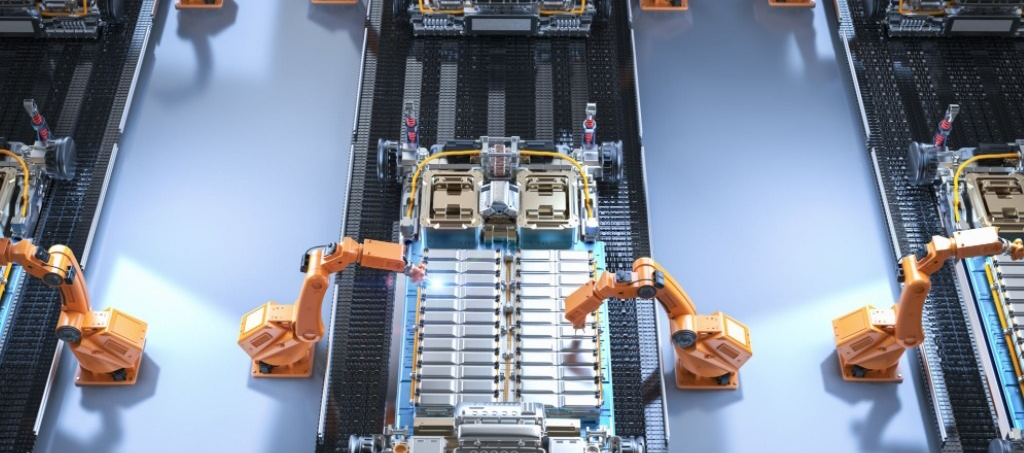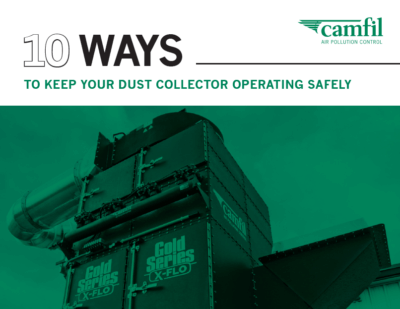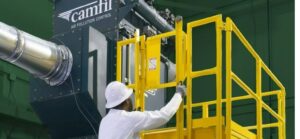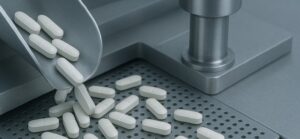Most electric vehicles (EVs) rely on lithium-ion batteries, which contain hazardous materials. These batteries pose various health and safety risks throughout their life cycle, particularly during production.
The risks arise from the chemical composition of battery cells, stored electrical energy and the potential for thermal runaway, a dangerous chain reaction that can lead to fires, explosions and the release of toxic chemicals.[1] When these toxic particles become airborne, they threaten workers’ health and safety, as inhalation of these toxins can have serious consequences. Poor indoor air quality (IAQ) also affects lithium-ion battery performance, efficiency and safety.
Growth of EV Production and Lithium-Ion Battery Demand
The growing global adoption of EVs is driving an unprecedented demand for lithium-ion batteries, prompting manufacturers to scale up production. Technological advancements, including solid-state battery development, are improving energy density, charging times and range, further accelerating market growth. With a rising focus on sustainable energy, the EV lithium-ion battery market is projected to reach USD 290.95 billion by 2032.[2]
Most EVs rely on lithium-ion batteries as their primary power source. These batteries contain highly toxic materials, including lithium, cobalt, nickel, manganese and graphite. The cathode is typically composed of lithium, nickel, manganese and cobalt, while the anode uses graphite. Lithium salt serves as the organic solvent.[3]
The Risk of Thermal Runaway and Air Contamination
During battery manufacturing, thermal runaway can cause a rapid temperature increase, leading to the emission of gas, vapor or smoke—and in extreme cases, visible flames. Fires resulting from thermal runaway can generate harmful chemical byproducts and harmful airborne particulates.[4] Worker exposure to these particles can lead to serious health problems.
Beyond safety hazards, particle contamination poses a major challenge for lithium-ion battery manufacturers. Miniscule particles trapped between the electrode and separator interfaces have been linked to battery fires and explosions. Additionally, contamination can cause performance issues, material defects, overheating and costly product recalls.[5]
Is the air inside your battery plant silently harming workers, reducing yield and increasing costs? If so, how can you prevent this?
The Silent Threat: How Airborne Contaminants Impact EV Battery Manufacturing
Lithium-ion batteries contain hazardous materials. The cathode typically consists of lithium, nickel, manganese and cobalt, while the anode is made of graphite. Lithium salt serves as the organic solvent. During processing, active electrode materials like graphite and lithium cobalt oxide are handled in powdered form, generating submicron airborne particles.[6]
Lithium’s fine particles can penetrate deep into the lungs, potentially causing respiratory issues. With a low density of 0.534 g/cm³, lightweight lithium particles easily become airborne, increasing the risk of inhalation.[7]
How Contaminants Affect Battery Performance
Maintaining air quality during manufacturing minimizes costly contamination, enhancing production yield and ensuring that a high-quality product reaches the end user.
For lithium-ion battery cells, clean materials make up 85% of the pack process materials cost. Minimizing contamination throughout production can significantly boost yield, which can drop to 50% if contaminant levels are not properly controlled.[8]
Key ways contaminants impact lithium-ion battery performance and safety:
Reduced charge capacity – Moisture contamination triggers a reaction in the electrolyte, producing hydrofluoric acid (HF). HF degrades both positive and negative electrodes, reducing the battery’s charge capacity.[9]
Short circuits – Metallic particles can infiltrate the battery during production. These contaminants can pierce the separator between electrodes, leading to internal short circuits, which degrade performance and pose significant safety risks.[10]
Fire hazards – Fine particles and moisture can compromise battery integrity, increasing the risk of thermal runaway, which can result in fires or explosions.[11]
Why Standard Air Filtration Systems Are Failing in Lithium-Ion Battery Plants
In lithium-ion battery manufacturing, proactively identifying and mitigating workplace hazards during process adoption and modification are crucial to preventing injuries and illnesses. Integrating hazard controls from the outset—during the design and construction phases—and reinforcing them through management and process adjustments ensure a safer work environment.[12]
However, traditional air filtration systems used in HVAC and cleanrooms often fail to capture the fine particulates that harm workers and damage battery cells. Common mistakes in factory air filtration include:
- Using low-grade HEPA filters that fail to capture nano-sized particles
- Inefficient air circulation, which allows contaminants to linger
- Overlooking VOC filtration, which is critical for lithium-ion battery safety
The Science Behind Effective Air Filtration in Lithium-Ion Battery Manufacturing
Lithium-ion battery manufacturers must adhere to strict standards, including maintaining ultra-low humidity and cleanroom environments. Failure to properly control humidity can lead to defects that reduce product lifespan and performance, increase the risk of overheating and, in extreme cases, cause ignition.
The manufacturing process involves multiple stages conducted in clean and dry rooms, depending on the airborne contaminants generated. Capturing and containing these particles before they enter the ambient air is crucial. As manufacturers expand production at existing facilities or build new ones, effective air filtration and dust collection planning are essential.
With advanced filtration technology, extensive experience and a broad product range, Camfil is well-equipped to support lithium-ion battery manufacturers in meeting their air filtration needs at every stage of production. Camfil’s key air filtration technologies for clean and dry room environments include:
HEPA & ULPA Filters for Nano-Particle Capture
Manufacturers operating under strict quality standards, including cleanroom environments, rely on high-efficiency particulate air (HEPA) and ultra-low penetration air (ULPA) filters in their HVAC and air handling systems.
- HEPA filters capture at least 99.97% of particles as small as 0.3 microns, ensuring a high level of air purity.
- ULPA filters offer even greater efficiency, trapping at least 99.9995% of airborne particles as small as 0.12 microns.
These advanced air filtration systems are essential for maintaining clean and controlled environments in lithium-ion battery manufacturing.
Camfil’s Megalam high-efficiency, energy-saving HEPA and ULPA filter panels are specially designed for turbulent and laminar airflow applications in high-tech cleanrooms, clean benches and clean air devices. Megalam air filters can capture 99.5% to 99.999995% of the most penetrating particle size (MPPS) of 0.1 to 0.3 microns—the size range most likely to penetrate filter media.
Activated Carbon Filters to Eliminate VOCs
Activated carbon is a highly effective and versatile adsorbent, capable of capturing the vast majority of airborne pollutants. One of its key attributes is its broad spectrum adsorption capacity, which enables it to trap various molecular contaminants—an essential feature when dealing with mixed pollutants.
Activated carbon can be produced from various raw materials and is available in different qualities, shapes and sizes. It functions through physical adsorption or catalytic action, and in some cases, both mechanisms play a crucial role. By optimizing these factors, Camfil’s activated carbon air filter media maximizes efficiency, lifespan and pressure loss to suit specific customer needs.
Molecular Filtration to Control Humidity and Chemical Exposure
Molecular filtration is essential for maintaining exceptionally clean indoor air in EV battery manufacturing plants. Even the most advanced traditional particle air filters cannot remove gases and vapors, as these pollutants exist at the molecular level. If left unfiltered, these airborne molecules can cause foul odors, reduced production efficiency, damage to products and equipment, and potential health risks.
Unlike particle air filters, molecular filters can effectively capture harmful gas and vapor pollutants. These filters are integrated into indoor recirculation systems to reduce pollutants generated within the facility. Additionally, they are used in outdoor make-up air systems to prevent contaminants from entering the workspace.
Camfil’s molecular filters are engineered to capture gases, vapor and molecules that are 1,000 to 10,000 times smaller than the particles HEPA and ULPA filters can trap. These air filters use adsorption, a process where molecules adhere to a large surface area of filter media such as activated carbon or alumina. For optimal air purification, molecular filters are often paired with HEPA filters, creating a comprehensive air filtration system.
Moreover, Camfil’s molecular air filtration products undergo rigorous testing in accordance with ISO 10121 standards, which evaluate the efficiency of molecular filter media and air filters against various gases. Alternatively, they can also be tested using ASHRAE 145.2, a laboratory method for measuring the performance of gas-phase air cleaners and filtration devices.
Importance of Dust Collectors in Lithium-Ion Battery Manufacturing
Lithium-ion battery manufacturers rely on dust collection systems to protect workers from hazardous dust, prevent contamination of products, stop harmful particles and fumes from accumulating on surfaces and comply with safety regulations and industry standards.
Cartridge-style dust collectors draw in large volumes of air to remove contaminants generated during production. As the polluted air enters the system through a baffled inlet, it moves through filters that trap impurities within the filter media.
The purified air is either recirculated back into the facility or expelled outdoors. Over time, dust accumulates on the filter media, increasing resistance and restricting airflow. To address this, the system uses a pulse cleaning method, which releases a burst of compressed air through the center of the filter, dislodging the dust and dropping it into a collection hopper.
Camfil’s advanced Gold Series dust collection systems, equipped with high-efficiency filter cartridges, are an excellent choice for lithium-ion battery manufacturing facilities. In EV battery production, high-efficiency filter cartridges with specialized filter media are typically required.
For example, HemiPleat eXtreme filter cartridges feature a blend of cellulose and polyester fibers coated with nanofibers, enhancing dust release efficiency. These filters are particularly effective in capturing dust generated throughout the various stages of battery chemistry mixing and productio
Case Study: How a Battery Separator Manufacturer Improved Dust Collection
Challenge: Battery separator manufacturer Entek International Limited relied on two DCE Sintamatic dust collectors for multiple production lines in their 24/7, 50-week operation. However, these collectors presented problems including high pressure drop, excessive dust carryover and costly, time-consuming filter replacements. These issues made maintenance particularly difficult, especially given the plant’s limited annual shutdown period of only two weeks.
Solution: Entek chose Camfil HemiPleat filter cartridges, which provide high efficiency and low pressure drop, along with the Gold Series industrial dust collector, designed for quick and easy filter replacement and lower operating costs.
Camfil designed, installed and commissioned two nearly identical systems, each featuring a GS8 unit with HemiPleat cartridges, a programmable compressed air cleaning system with an air saver, twin hoppers with motorized rotary valves, and a HEPA filter system for additional backup filtration. Read the full story.
Action Plan: How EV Lithium-Ion Battery Manufacturers Can Optimize Air Filtration Today
- Step 1: Conduct an air quality audit in the battery plant to identify existing contaminants, pinpoint areas of concern and determine the most effective filtration solutions.
- Step 2: Upgrade to high-efficiency HEPA, ULPA and molecular filtration. These advanced filters effectively capture ultrafine particles, harmful gases and vapors, ensuring a cleaner and safer production environment.
- Step 3: Implement real-time air monitoring to track contaminant levels. Early detection of air quality issues allows for timely corrective actions to maintain optimal conditions.
- Step 4: Partner with Camfil air filtration experts to ensure that systems are correctly designed, maintained and upgraded to meet industry standards and efficiency goals.
Conclusion
Understanding how EV lithium-ion battery production machinery operates—and the emissions it generates—is essential, particularly since much of this equipment is custom-built for the industry. By combining this knowledge with Camfil’s clean air solutions, manufacturers can evaluate compliance with health, safety and environmental standards.
However, initial validation is just the first step—continuous monitoring of the production process is equally important. To ensure workplace exposure limits are not exceeded, it’s crucial to keep both the production machinery and the ventilation and extraction systems running efficiently.
Contact Camfil’s experts to help you safeguard your EV battery plant, employees, products and equipment from hazardous dust, fumes, vapors and gases.
FAQs
- Why is air quality so important in EV battery production? Clean air is essential for protecting workers, preventing product contamination and ensuring compliance with health, safety and environmental regulations.
- What types of filters are best for lithium-ion battery manufacturing? High-efficiency HEPA, ULPA and molecular filters are ideal for capturing ultrafine particles, harmful gases and vapors in lithium-ion battery production.
- How do air contaminants cause battery defects? Airborne particles and chemical contaminants can interfere with the battery chemistry, leading to performance issues, reduced efficiency and potential safety risks.
- How often should EV battery manufacturers replace their air filters? Filter replacement frequency depends on the quality of the air filters, usage, contamination levels and system design, but regular monitoring helps to ensure optimal performance and compliance.
- How can I get an air quality assessment for my battery plant? Contact air filtration experts like Camfil to schedule an on-site assessment and receive tailored recommendations for improving air quality.
[1] Lithium-ion Battery Safety, OSHA Factsheet
[2] Growth Trends in the Electric Vehicle (EV) Lithium-Ion (Li-ion) Battery Industry, 2024-2032: A Projected $290 Billion Landscape, Research and Markets
[3] A Guide to Dust Collection in Battery Manufacturing, Camfil APC
[4] Lithium-ion Battery Safety, OSHA Factsheet
[5] The Crucial Role of Air Quality Control in EV Battery Production Plants, Camfil
[6] The Crucial Role of Air Quality Control in EV Battery Production Plants, Camfil
[7] A Guide to Dust Collection in Battery Manufacturing, Camfil APC
[8] E-mobility battery cell plants, Camfil
[9] How contamination affects EV battery performance, SMT Worldwide
[10] Halting contamination in R2R battery manufacture, Converting Quarterly
[11] Lithium-ion Battery Safety, OSHA Factsheet
[12] Lithium-ion Battery Safety, OSHA Factsheet
 Americas
Americas 




